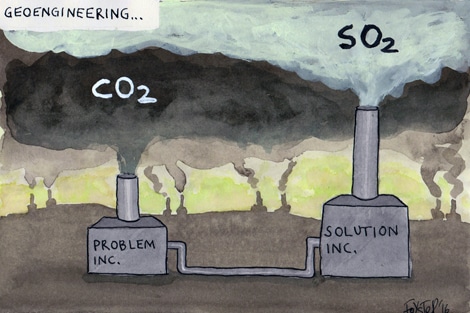by Greg Foyster (Eureka Street)
It’s a credo of consumer capitalism: never address the cause when you can create an industry treating the symptoms.
This is the logic behind many profitable businesses, from cholesterol-lowering pills that compensate for poor diet and lack of exercise to factories that recycle unnecessary packaging.
Now there’s a new technofix on the table, and it’s called geoengineering. Geoengineering means intervening in the Earth’s climate to counter, or offset, global warming. It’s hacking the planet on a monumental scale.
Some proposals sound like pure science fiction. Building ‘artificial trees’ to suck in carbon dioxide. Fertilising entire oceans with iron, trigging carbon-sequestering algal blooms. Launching a fleet of ships to patrol the ocean, pumping seawater into the air to ‘brighten’ marine clouds.
The most ambitious and widely studied is spraying sulphate particles into the upper atmosphere to reflect sunlight, cooling the planet.
The idea comes from huge volcanic eruptions, which can blast millions of tonnes of sulphur into the stratosphere, creating a kind of chemical sunshade. When Mount Pinatubo in the Philippines erupted in 1991, the Earth cooled by about half a degrees Celsius over the next year.
After decades of being taboo, this outlandish scheme, called ‘solar radiation management’, is now being taken seriously. It’s been explored through scientific papers in major journals, reports of the UK’s Royal Society, hearings in the US Congress, and a recent report of the US National Academy of Sciences.
Some environmentalists and climate scientists say it may be a ‘necessary evil’ to avoid catastrophic climate tipping points. Controversially, the most recent IPCC Assessment Report mentioned geoengineering in the prominent final paragraph of its Summary for Policymakers.
“Dimming the sun wouldn’t solve the other problems caused by carbon pollution. Dissolved carbon dioxide would still acidify our oceans. The climate would still change.”
There are deep pockets behind it too. Techno-philanthropist Bill Gates is a leading financer. Venture capitalists are circling, and some proposals have already been patented.
A firm called Intellectual Ventures owns the intellectual property for the ‘StratoShield‘, an invention to deliver sulphur dioxide into the upper atmosphere through a 30-km-long hose supported by balloons. A professor at Harvard, David Keith, is pushing for more research and testing.
Neoconservative think tanks have leapt at the technology, arguing it’s a cheaper solution to global warming than cutting emissions and restructuring the economy. Once the post-Paris Agreement buzz wears off and governments realise the hard work ahead of them, they might find this line seductive.
As a thought experiment to highlight the warped logic behind geoengineering, I’m proposing my own climate-hacking invention. It’s called The Problem-Solution Generator, and it has two parts.
The ‘Problem’ is a dirty coal power station that spews carbon dioxide into the lower atmosphere, overheating the planet. Burning coal also releases other forms of air pollution — sulphur dioxide, nitrogen oxides, soot particles and mercury — responsible for millions of deaths worldwide.
The ‘Solution’ is a 30-km-high smoke stack which separates the sulphur dioxide emissions and pumps them into the stratosphere, where they won’t make people sick and should cool the planet. Thus a single machine generates a problem and then solves it — The Problem-Solution Generator!
Of course, we could shut down coal power stations and not create the problem in the first place. But that would address the cause — rising carbon emissions — which isn’t what technofixes like geoengineering are about. So let’s continue the thought experiment, using some of the same arguments as for other sulphur-spraying ideas.
Advocates of solar radiation management say that, unlike other responses to global warming, it doesn’t upset the economic or political status quo. It’s as if the current composition of society is more permanent and fixed than the composition of the entire upper atmosphere.
The Problem-Solution Generator shares this assumption. Fossil fuel companies could continue making money off heating the planet, while also making money off cooling the planet. It’s a win-win!
There are a few concerns. Previous large volcanic eruptions have been associated with lower global rainfall and famine. Climate modelling indicates solar radiation management might dry the Amazon and disrupt the Asian and African monsoons. The sulphur particles could damage the ozone layer.
The biggest fear is switching the off button. Carbon dioxide persists in the atmosphere for centuries, but sulphur particles only stick around the stratosphere for a few years, so if we suddenly stop pumping the stuff up there, the temperature could spike abruptly. The faster the rate of warming, the less time plants and animals have to adapt, risking widespread ecosystem collapse.
But in the spirit of Silicon Valley techno-optimism, let’s look at these as opportunities. Lower global rainfall? That’s an opportunity for a spin-off industry in cloud-seeding drones. Disrupted monsoons? They’ll mostly affect poor African and Asian subsistence farmers, so the cost to the global economy will be small. Dangerous to stop once we start? That just shows what a great business model it is!
Dimming the sun wouldn’t solve the other problems caused by increased carbon pollution. Dissolved carbon dioxide would still acidify our oceans. The climate would still change, just differently. We might still see mass extinctions and so forth. But our clever minds will soon solve these problems too. The important thing is that we maintain our faith in human progress.
Sound crazy? This kind of thinking is actually conventional. The underlying assumption of Western industrial society is that nature is a resource for our exclusive use. Geoengineering just takes this domination of the natural world to its logical extreme. In one sense, complete control of the planet is where our civilisation has been heading for centuries.
In Earthmasters, Clive Hamilton writes that geoengineering proposals ‘entail building a vast industrial infrastructure in order to counter the damage done by another vast industrial infrastructure’. If the Problem-Solution Generator seems colossally stupid, it’s only because it makes the stupidity of geoengineering technofixes utterly transparent.
Greg Foyster is an environment journalist, an alumni of Centre for Sustainability Leadership, and the author of the book Changing Gears.
Cartoon by Greg Foyster




